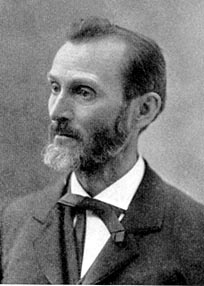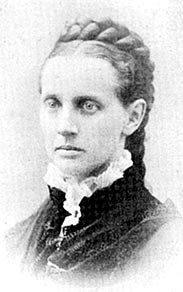Aaron Schuyler
1828-1913
 Aaron Schuyler, the ninth child of John Brognard and Elizabeth (Turner)
Schuyler, was born February 7, 1828 in Genesee County, New York. He was
a descendant of Philip Pieterse Schuyler, who emigrated from the
Netherlands to America in the 17th century. In 1834 John Schuyler
brought his family to the wilderness of Seneca County, Ohio, where they
cleared land and established a farm near the town of Attica.
Aaron Schuyler, the ninth child of John Brognard and Elizabeth (Turner)
Schuyler, was born February 7, 1828 in Genesee County, New York. He was
a descendant of Philip Pieterse Schuyler, who emigrated from the
Netherlands to America in the 17th century. In 1834 John Schuyler
brought his family to the wilderness of Seneca County, Ohio, where they
cleared land and established a farm near the town of Attica.
Sometime in 1849 Aaron Schuyler enrolled in the Seneca County Academy at
Republic, Ohio. Although he was but a "slender country lad," he was one
of the more advanced pupils, having already spent two terms at an
academy in Norwalk. Less than a year later the principal of Seneca
County Academy resigned, and the students petitioned the Board of
Trustees to elect Schuyler as the new principal, which they did. He
served in that post for twelve years, until the Civil War greatly
depleted the ranks of the student body. During his tenure the Academy
enrolled as many as 500 students from Ohio and other states, and its
reputation is said to have rivaled that of Oberlin College.
Schuyler married Amanda Pearce in 1851, and they had three daughters.
In the fall of 1861 he was elected to the chair of mathematics at
Baldwin University, a Methodist institution located in Berea, Ohio.
When the Schuylers moved to Berea in the summer of 1862, it was a rural
town with a population of about 800. The following year the German
department established German Wallace College, which would exist as a
separate institution for 50 years until a 1913 merger created
Baldwin-Wallace College.
In 1875 Schuyler was elected president of Baldwin University, a position
that he held for ten years. During that time he continued as professor
of mathematics and philosophy. He was awarded honorary degrees from
Ohio Wesleyan University (A.M. in 1860), Otterbein University (LL.D. in
1874) and Kansas Wesleyan (Ph.D. in 1887).
While teaching in Ohio, Schuyler wrote a series of college mathematics
textbooks including: Higher Arithmetic (1860), Complete Algebra for
Schools and Colleges (1870), Elements of Geometry (1876), Plane and
Spherical Trigonometry (1875), and Surveying and Navigation (1873).
Except for the higher arithmetic, these were published in Cincinnati by
Wilson, Hinkle & Co., and may have been seen as successors to the
popular Ray's Mathematical Series. In fact, Schuyler had been the
author of Ray's Surveying and Navigation. He was known for being a good
expositor, and it was said that he could "make rough places smooth and
crooked things straight." On the other hand, many teachers felt that
his arithmetic and algebra books were too difficult, as they emphasized
logical thinking over memorization and computation.
Besides mathematics, Schuyler taught philosophy, Latin, Greek, English
literature, and Biblical interpretation. He published books on logic,
psychology, systems of ethics, and history of philosophy. At the time
of his death he was completing a manuscript on analytic geometry.
E. S. Loomis described Schuyler as "a good mathematician, far above
average, ... but not an Abel nor a Gauss." From 1855 to 1857, Schuyler
submitted solutions to 35 of the 56 problems posed in the Mathematical
Department of The Ohio Journal of Education. Two of these had been
posed by Schuyler himself -- one involved the area of a circular segment
and the other asked for the product of Zero and Infinity.
In the 1860's he published articles in the
Ohio Educational Monthly on topics such as "Least Common
Multiple" (1863), "How Should Arithmetic Be Taught to Advanced Classes?"
(1865), and "How to Teach
[place value] Notation" (1866).
 In 1884-85 Schuyler served as president of both the Ohio College
Association and the Ohio Teachers' Association. His presidential
address to the latter on "The Sensibility: Its Phenomena and Education,"
delivered in July, 1885, was his last educational work in Ohio. He
resigned from Baldwin University that year to become professor of
mathematics and philosophy at the newly founded Kansas Wesleyan
University in Salina, Kansas. From 1889-1912 he also served as
president of that institution. He retired in 1907 and made his home in
Salina until his death on February 1, 1913.
In 1884-85 Schuyler served as president of both the Ohio College
Association and the Ohio Teachers' Association. His presidential
address to the latter on "The Sensibility: Its Phenomena and Education,"
delivered in July, 1885, was his last educational work in Ohio. He
resigned from Baldwin University that year to become professor of
mathematics and philosophy at the newly founded Kansas Wesleyan
University in Salina, Kansas. From 1889-1912 he also served as
president of that institution. He retired in 1907 and made his home in
Salina until his death on February 1, 1913.
Professor Schuyler had an assistant in mathematics at Baldwin University
named Ellen H. Warner (left). Born in Liverpool, Ohio, in 1844, she graduated
from Baldwin in 1869. Her review of Schuyler's Higher Arithmetic was
published in the Ohio Educational Monthly in 1865. She was at first
employed as a "tutor in mathematics" but was soon given the title of
Professor. E. S. Loomis refers to her as an "exacting drill-mistress,"
and as Dr. Schuyler's "highly efficient helper." She wrote A Key to
Schuyler's Complete Algebra, published in 1874, and also prepared the
solutions to the problems in his Trigonometry. She taught at Baldwin
University until 1881 and at some time received an [honorary] Ph.D.
degree.
REFERENCES
- Loomis, Elisha S., Life and Appreciation of Dr. Aaron Schuyler, Berea, Ohio, Mohler Printing Co., 1936.
- Wilker, Victor, "Aaron Schuyler - A Character Sketch," Baldwin Wallace Alumnus, 6 (1921).
Article by David E. Kullman
Miami University
 In 1884-85 Schuyler served as president of both the Ohio College
Association and the Ohio Teachers' Association. His presidential
address to the latter on "The Sensibility: Its Phenomena and Education,"
delivered in July, 1885, was his last educational work in Ohio. He
resigned from Baldwin University that year to become professor of
mathematics and philosophy at the newly founded Kansas Wesleyan
University in Salina, Kansas. From 1889-1912 he also served as
president of that institution. He retired in 1907 and made his home in
Salina until his death on February 1, 1913.
In 1884-85 Schuyler served as president of both the Ohio College
Association and the Ohio Teachers' Association. His presidential
address to the latter on "The Sensibility: Its Phenomena and Education,"
delivered in July, 1885, was his last educational work in Ohio. He
resigned from Baldwin University that year to become professor of
mathematics and philosophy at the newly founded Kansas Wesleyan
University in Salina, Kansas. From 1889-1912 he also served as
president of that institution. He retired in 1907 and made his home in
Salina until his death on February 1, 1913.
 Aaron Schuyler, the ninth child of John Brognard and Elizabeth (Turner)
Schuyler, was born February 7, 1828 in Genesee County, New York. He was
a descendant of Philip Pieterse Schuyler, who emigrated from the
Netherlands to America in the 17th century. In 1834 John Schuyler
brought his family to the wilderness of Seneca County, Ohio, where they
cleared land and established a farm near the town of Attica.
Aaron Schuyler, the ninth child of John Brognard and Elizabeth (Turner)
Schuyler, was born February 7, 1828 in Genesee County, New York. He was
a descendant of Philip Pieterse Schuyler, who emigrated from the
Netherlands to America in the 17th century. In 1834 John Schuyler
brought his family to the wilderness of Seneca County, Ohio, where they
cleared land and established a farm near the town of Attica.